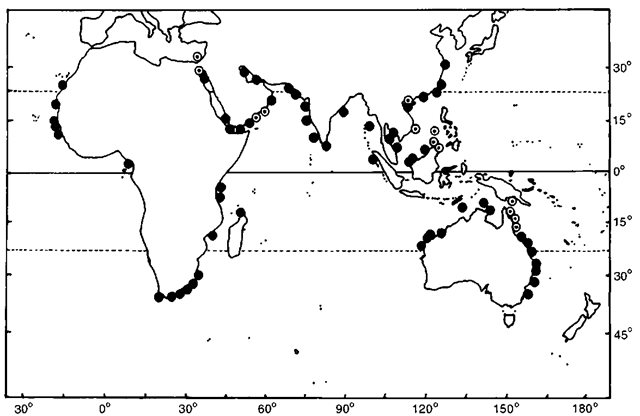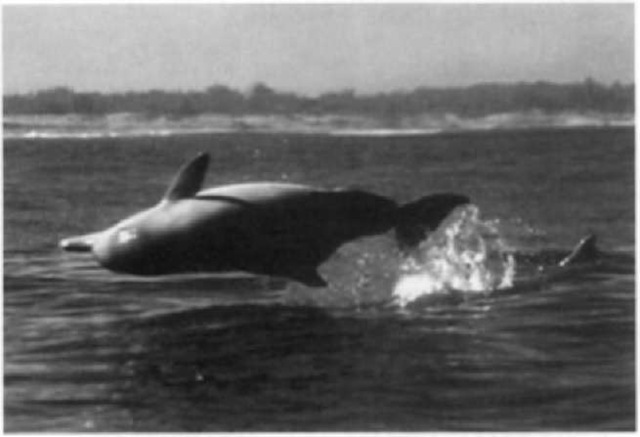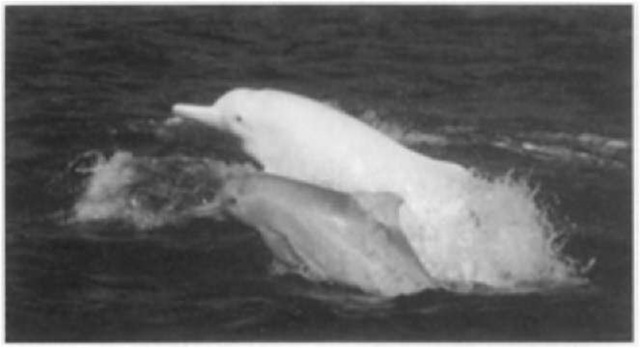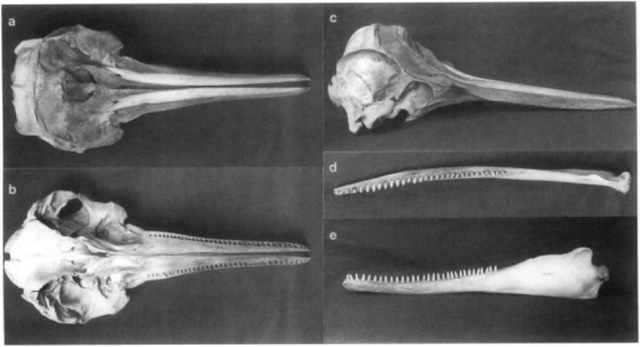The names given to the humpback dolphins, genus Sousa, reflect both their distribution (Fig. 1) and their distinctive humped appearance when they surface (Figs. 2 and 3). These coastal animals occur in small groups from northwestern Africa to northern China and Australia and are subject locally to incidental mortality in nets. Their biology is poorly known and their classification is open to discussion, not least because study material across the range is limited.
Figure 1 Distribution of Sousa worldwide. Closed and open circles represent specimens and sightings, respectively.
Figure 2 Subadult Sousa in Richards Bay, southern Africa, showing the humped back and ridged dorsal fin base typical of animals westward of Sri Lanka.
I. Description
Humpback dolphins are medium sized and robust in form. The melon, moderate in size, is slightly depressed and, in profile, slopes gradually to an indistinct junction with the long, narrow snout. Neonates have vibrissae. The gape is straight. The broad flippers are rounded at the tip, and the flukes are broad and full, with a deep median caudal notch. Dorsal and ventral ridges on the caudal peduncle are well developed in African and Indian Ocean populations. The distinctive dorsal fin comprises a thickened base supporting a thinner, fin-shaped upper component; its overall form varies geographically (Figs. 2 and 3). Its length varies in relation to body length. Total length reaches a maximum of 2.5-2.8 m in different parts of the distribution. South African males and females are sexually dimorphic; mean lengths and weights for fully grown males are 2.70 m and 260 kg compared to 2.40 m and 170 kg in females. The few available data suggest that Arabian Gulf animals may also be dimorphic in length. The biology of any population is poorly known. These dolphins live close to shore in depths of 25 m or less. Characteristic features of the skull include a long narrow rostrum, strengthened by raised premaxillary bones and increasingly compressed toward the tip (Fig. 4), large temporal fossae on which the jaw muscles insert, and pterygoid bones that are separated in the midline by up to 11 mm. A broad gap exists between the posterior margin of the maxillary bones and the supraoccipital crest of the skull. The mandibular symphysis is long, and each jaw bears 27 to 38 teeth, wedge-shaped at their base.
Figure 3 Adult female Sousa chinensis and her calf off North Lantau Island, Hong Kong, showing the total loss of gray body pigment during growth.
II. Distribution
Atlantic humpback dolphins occur widely along the West African coast, between southern Morocco (23°54′N) and Cameroon. Indo-pacific humpback dolphins are distributed continuously along the coast from False Bay, South Africa to the South China Sea, including the Red Sea, Arabian Gulf, the Indian subcontinent, Gulf of Thailand, Malacca Straits and northern Borneo, and the coast of China to the Yangtze River (31°50′N). At least one animal reached the Mediterranean via the Suez Canal (Fig. 1). Australian animals reach 25°S on the west coast, extending to 34°S facilitated by the warm eastern boundary current; similarly, those resident in southern South Africa live at 34°S in water temperatures of 15-22°C.
III. Taxonomy
The taxonomy of the genus is not well established, partly because sample sizes for morphological and genetic comparisons are small for most populations. Three species were recognized by Rice (1998): Sousa chinensis (Osbeck, 1765), S. plumbea (G. Cuvier, 1829), and S. teuszii (Kukenthal, 1892). Other nominal species include S. lentiginosa (Owen, 1866) and S. borneensis (Lydekker, 1901). However, recent morphological studies, supported somewhat equivocally by genetic analyses, indicate that there is a single, variable species for which the name S. chinensis has priority.
IV. Regional Differences
Regional differences occur in external proportions, especially in body length, snout length, and the length of the dorsal fin base, although data on the mean or maximum body length exist for few populations. Animals in northeastern Australia and Hong Kong waters attain 2.3-2.5 m in length; Indian dolphins are generally shorter than 2.6 m; however, four animals exceeded 3.0 m in length. Beak length varies from about 6% of total length in West African animals to about 10% in northeast Africa. Dorsal fin height varies only in relation to total length, rather than regionally. In dolphins from Sri Lanka westward, the base of the dorsal fin forms a distinct elongate mid-dorsal ridge with a small, falcate upper component (Fig. 2). The basal part includes vascular structures similar to those in the dorsal fin of other delphinids, perhaps assisting in thermoregulation, and may attain 39% of body length in southern African animals. Eastward of Sri Lanka, the fin base comprises a broad, thickened pad that rises slightly above its surroundings surface and supports a larger, almost triangular upper component with a rounded tip (Fig. 3). The few specimens known from the east coast of India suggest that the transition from one form of fin to the other occurs in this region.
Figure 4 Dorsal (a), ventral (b), and lateral (c) vieivs of the skull, and dorsal (d) and lateral (e) views of the mandible of an adult male Sousa from South Africa.
Color varies greatly, with age and location, in both the timing and extent of the loss of the gray background color to become white (pink when flushed) and the development of spotting on the flanks and back. Bom with a typical neonatal dark-grayish pigmentation above and paler gray below, animals lose gray pigmentation at different rates. Thus populations on the coast of China pale earlier than any other, turning white or pink within a few years of birth, a process that takes considerably longer in Australian and other populations to the west. Dolphins from eastern India to the Arabian Gulf coastline become spotted with white as mature adults, and there is 110 such pigment loss in any African population other than a pale fin mark in some southern African adults. Black spotting over the head and body dev elops in adults of all populations from the Arabian Gulf eastward.
Skull morphology is similar in all populations, apart from lower tooth counts, a shorter mandibular symphysis, and a broader cranium in West African animals. However, such low tooth counts may reflect small sample size, as the well-sampled southern African population varies greatly (30-38 teeth). The median number of teeth per jaw increases eastward from 28 or 29 in West African animals to 36 or 37 teeth in north Indian Ocean populations and declines to 32 or 33 teeth in Southeast Asian and Australian animals. Regional differences occur in the ear bones of different populations. The range of vertebral formulae in South African animals was C7 Tll-12 L9-12 Cd 20-24 = 49-52. Vertebral counts in humpback dolphins further east are similar to those of the South African sample (49-53), and West African humpback dolphins have 52-53 vertebrae.
V. Habitat
Humpback dolphins rarely occur in waters more than 25 111 deep throughout their range. Saline, often turbid, waters in mangrove channels, embayments, and tropical river deltas or over shallow banks form important habitats. Occasionally they occur offshore, such as in the Great Barrier Reef, usually associated with islands or reefs, or in reef lagoons, such as Ninga-loo Reef, Western Australia. Along the high-energy southern African coast, where sandbars limit access to rivers, humpback dolphins generally occur less than 1 kin offshore, often close to the surf zone; conversely, in southern China, dolphins may swim up rivers for tens of kilometers.
VI. Behavior
Humpback dolphins swim slowly at about 5 km/hr, surfacing briefly at intervals of up to a minute. Longer dives may last up to 5 mill. Typically they avoid boats and rarely bow ride. When approached, they generally dive, split up into small groups or single animals, and often change course underwater, reappearing unexpectedly some distance away. When a dolphin surfaces, the beak or occasionally the whole head is typically raised clear of the water and the body is arched, humping the back and perhaps exposing the flukes, before sounding. In one study, movement, feeding, social activities, and resting accounted for 49, 27, 15, and 8% of observation time, respectively. Single animals or pairs are generally adult; immatures tend to associate with groups containing more than one adult. Calves form about 10% of the population. Group size is generally 4 to 7 (range 2 to about 25). Body contact, displays during swimming, leaping and chasing, or activities focused on inanimate or animate objects form part of the behavioral repertoire.
VII. Biology
These dolphins feed primarily on fish and cephalopods in shallow reef, littoral, or estuarine-associated habitats. Senegalese dolphins follow the rising tide into mangrove channels to feed, returning with the ebb tide, and South African dolphins spend more time feeding on the rising tide. Temporary beaching by dolphins to retrieve bonefish deliberately washed onto exposed sandbanks has been reported. Fishes in the families Haemuli-dae, Sciaenidae, Sparidae, Mugilidae, and Clupeidae and cuttlefishes (Sepiidae) are the most important prey across the range of Sousa. Notably, the first three of these families produce underwater sounds, which may assist dolphins to detect their prey.
Clear evidence of migration in humpback dolphins has not been found, although Senegalese animals may shift northward in summer. Humpback dolphins on the southern Cape coast of South Africa appear to be resident, and those in southern China are present throughout the year.
The effects of predation on humpback dolphins are uncertain. Off Natal, some 35% of these dolphins captured in nets bear healed shark bites, suggesting that shark attack is a significant cause of mortality, as this sample merely represents the survivors of such attacks. The few records of parasites include the whalelouse Syncyamus aequus and the nematode Halocer-cus (?) pingi.
Sound production and reception are vital to humpback dolphins in the often murky habitat they occupy. They produce clicks comprising highly directional single pulses repeated in series at variable rates between 10 and 500 Hz, apparently used for echolocation. Whistles and screams are frequency-modulated sounds: the former are produced singly or in series and are of variable length (milliseconds to seconds), whereas screams have a harmonic structure and occur in series. These may be important in communication, as their high-frequency components exceed the frequency range of sounds produced by fish and crustaceans and ambient environmental noise. The cochlear nerve in Sousa is specialized with large nerve fibers, permitting rapid transfer of information to the brain; the largest of some 77,000 fibers in this nerve are 50 |xm in diameter, the greatest observed in any vertebrate.
Reproductive and other life history data are minimal for all populations. Calves are about 1 m long at birth. Off South Africa, births occur throughout the year, two-thirds of which are in summer; females mature at about 10 years old and males about 3 years later, assuming one growth layer group in teeth per year. The length at maturity is unknown. Data from other populations are minimal. The fat content of humpback dolphin milk is about 10%, similar to that of bottlenose dolphins but lower than that of common dolphins. Copulation occurs with one dolphin inverted below its partner, lasting 20-30 sec. Observations of dolphins rising vertically belly to belly in a vertical position in the Arabian Gulf and the Indus delta have been ascribed to mating behavior.
VIII. Relationships
The relationships of Sousa with other delphinoid genera are equivocal. Air sinus structure suggests that Sousa and Steno are closely related, whereas earbone structure places Cephalo-rhijnchus with these two genera as a closely related group comprising the subfamily Sotaliinae. More recent genetic studies indicate that Sousa is a member of the Delphininae. No fossils of Sousa are known.
IX. Human Influence
Humpback dolphins from South African, Australian, and Thai populations have survived in captivity for periods from 3 months to over 30 years. In southern Queensland, up to seven free-ranging humpback dolphins visit Tin Can Bay regularly where they are fed fish by visitors. Humpback dolphins are particularly susceptible to the effects of human activities in the coastal zone, especially fishing. Incidental catches in nets are reported for West Africa, northeastern Africa, the Arabian Gulf, Indus delta, and southwestern India. Off Natal, shark nets set to protect bathing beaches caught at least 67 humpback dolphins between 1980 and 1989, from a population of unknown size, although clearly small. Catch data for humpback dolphins in Australian protective nets are unknown. Changes in the Indus delta and other tropical regions through construction, drainage, and destruction of mangroves strongly affect the prime habitat of humpback dolphins.
Organochlorine residues are evident in several populations. In three southern Indian animals, total DDTs and PCBs in blubber reached 11.000-14,000 ppm and 920-1800 ppm, respectively. Off Natal, total DDT levels in blubber ranged from 59 to 243 ppm and PCBs 1000 to 130,000 ppm, the highest residue level for any marine mammal of that region. Mercury pollution levels of up to 0.9 ppm in Hong Kong Sousa present a potential threat to this population.
The conservation status of almost all populations of humpback dolphins throughout their range is uncertain, primarily because the monitoring of mortality rates is minimal in most regions and determining population size is difficult, even locally, although all appear to be small. Simple population estimates for the Indus delta and the Saloum delta, Senegal, are 500 and 100 animals, respectively. Density in Moreton Bay, southeast Queensland, is estimated at 0.1 dolphin/km2.




